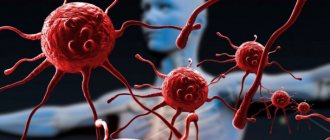Parasitic diseases. How to suspect and diagnose?
Parasitic diseases are a widespread, diverse group of diseases caused by helminths and protozoa, which undergo a life cycle in the human body, feeding and reproducing at the expense of the “host” and causing damage to various organs and systems. Considering the effect on the entire body as a whole, it is quite difficult to suspect and recognize them.
How does infection occur?
Before entering the human body, helminths and protozoa undergo a development cycle in other environments or living organisms.
- In the soil under certain conditions of temperature and humidity, eggs and larvae of roundworms, strongyloides, hookworms are preserved. A person becomes infected when contaminated soil comes into contact with dirty hands, water, unwashed fruits and vegetables, directly with the soil.
- The following helminths undergo development cycles in living organisms: opisthorchid (cat fluke), clonorchid, trichinella, toxocara, echinococcus, pork and bovine tapeworm. Before reaching maturity to parasitize humans, a change of one or two intermediate hosts is possible. These are mollusks, crustaceans, fish, insects. Consumption of thermally insufficiently processed fish and meat, or raw water leads to infection.
Another route of infection is through direct contact between people through handshakes, shared hygiene and household items, or through self-infection. We are talking about contagious helminths: enterobiasis, strongyloidiasis, cysticercosis, giardiasis.
How can you suspect a parasitic disease?
Manifestations can be varied, ranging from mild to severe. Rarely do typical signs that indicate a specific pathogen occur. Often there are no signs, or they are disguised as other diseases, or disappear as one development cycle of the parasite ends and another begins. For example, roundworm larvae first enter the human lungs, where they mature and migrate to the intestines. The child may be bothered by a short cough (similar to a cold), which does not alert the parent.
However, acute and chronic phases of the course of a parasitic disease are usually distinguished.
Acute manifestations arise due to the general effect on the body:
- The effects of toxins are an increase in temperature to 37 - 37.5 degrees, weakness, headaches, decreased mood and performance, sleep disturbances;
- Allergic reactions - skin itching, urticaria, bronchospasm, shortness of breath, less often Quincke's edema;
- Activation of the immune system – pain in muscles and joints; enlarged lymph nodes, liver and spleen
- Mechanical impact - if you look under a microscope, each helminth can see devices for securing itself in the body, injuring the mucous membrane: teeth, hooks, suction cups. As a result, abdominal pain, frequent bowel movements, and dyspepsia occur.
The chronic phase is characterized by damage to certain organs and systems. Most often, the intestines suffer; prolonged mechanical impact leads to inflammation, disturbances in absorption and digestion of food. Anemia, a lack of vitamins and microelements develops, and young children experience delayed growth and weight gain. The gallbladder and bile ducts may be affected (giardiasis); cardiovascular system, lungs, nervous system (usually trichinosis); lungs and liver (echinococcosis) and so on. Over a long period of time, the immune system is suppressed and secondary infections occur.
So, we have many routes of infection, mechanisms of development and manifestations of parasitic diseases. It turns out that every second person has a risk of getting sick, right? But sometimes helminths may not stay in the body: they die and leave, or pass by without starting to parasitize (which is why the discovery of a “worm” in the feces does not prove the presence of the disease). Much depends on the stage of the helminth, its invasive properties and the human immune system. Children under 5 years of age who actively learn the world “by language” and people with chronic diseases and weakened immune systems are more susceptible to the development of helminthiasis.
If you find any of the listed signs, take a clinical blood test with a leukocyte formula. An increase in eosinophils to 7-10% or more will be another suspicious criterion.
How to identify a parasitic disease?
- Examination of stool for protozoa and helminth eggs, preferably the enrichment method - PARASEP Determines eggs of all types of helminths and protozoa living in the intestines
The criterion for disease activity is the detection of eggs! This means going through the cycle of helminth development in the body, its parasitism and reproduction. These are mainly intestinal helminthiases, when a person is the final host, the “permanent place of residence” of the parasite, and eggs are necessary for further spread and the beginning of the next cycle.
Please pay attention to the following points:
- Each helminth has its own development cycle, so a one-time study is not enough. If the result is negative, a three-time study is recommended with an interval of 3-7 days.
- There are forms of helminthiasis when a person is an intermediate host (a carrier of helminth larvae) or a “biological dead end”, when the larvae have confused the host and cannot develop further at all. In such cases, eggs will never appear in the stool; the disease can only be detected by detecting antibodies (see below)
- Examination of scrapings for enterobiasis reveals only pinworm eggs in the perianal folds. Female pinworms lay eggs, leaving the intestines exclusively at night, when a person is relaxed. Therefore, the study is carried out strictly after sleep BEFORE washing up!
- Testing the Giardia antigen in feces is a highly accurate method for identifying Giardia. For better detection, it is recommended to adhere to a choleretic diet before the study.
- The study of antibodies to helminths (immunoglobulins) is aimed at assessing the immune system to pathogens. Basically, the most persistent immunoglobulins are determined - class G (IgG), which reflect the fact of infection, but do not allow us to understand whether there is a helminth in the body now or not, since IgG remains in the body for a long time in the “memory archive”.
What should you pay attention to?
- The presence of manifestations and the simultaneous detection of IgG may indicate the chronic phase of helminthiasis
- In doubtful cases, a repeat IgG test is recommended after 2 weeks. An increase in antibody levels by 2 times or more indicates helminth activity
- For trichinosis, echinococcosis, and cysticercosis, antibody determination is the only possible method of laboratory diagnosis, since humans are the intermediate host for these helminths.
For your convenience, a complex “Diagnostics of parasitic diseases” has been created, including a clinical blood test, general IgE (allergic component) and determination of antibodies to the most common helminths and protozoa.
Classification
There are a large number of classifications of infectious diseases. The most widely used classification of infectious diseases by L. V. Gromashevsky:
- intestinal (cholera, dysentery, salmonellosis, escherichiosis);
- respiratory tract (influenza, adenovirus infection, whooping cough, measles, chicken pox);
- “blood” (malaria, HIV infection);
- external integument (anthrax, tetanus);
- with different transmission mechanisms (enterovirus infection).
Depending on the nature of the pathogens, infectious diseases are classified into:
- prion (Creutzfeldt-Jakob disease, kuru, fatal familial insomnia);
- viral (influenza, parainfluenza, measles, viral hepatitis, HIV infection, cytomegalovirus infection, meningitis);
- bacterial (plague, cholera, dysentery, salmonellosis, streptococcal, staphylococcal infections, meningitis);
- protozoans (amoebiasis, criticalosporidiosis, isosporiasis, toxoplasmosis, malaria, babesiosis, balantidiasis, blastocystosis);
- fungal infections, or mycoses, (athlete's foot, candidiasis, cryptococcosis, aspergillosis, mucormycosis, chromomycosis).
Plague of Justinian
The Plague of Justinian, a pandemic of bubonic plague that swept through Asia Minor, Africa and Europe, struck Constantinople, the capital of the Eastern Roman (Byzantine) Empire, in the late spring and summer of 542 AD. e. After the plague began in Egypt, merchant ships and troops carried it throughout the Western world, allowing the disease to break out repeatedly over the next 50 years.
According to Procopius, the Greek historian and court insider who is our main source, the epidemic began near Ethiopia. Although ancient traditions claimed that diseases came from Africa, there may be some truth to Procopius's story. The plague bacillus appears to have originated in both central Africa and India, with the latter also being the likely home of a species of black rat that carried the plague. Ships sailing the Indian Ocean and Red Sea on their way to Egypt could have brought the rat and the bacillus together in a deadly combination.
People were terrified, many attributed the disease to the touch of a supernatural creature that appeared in a dream or in reality. To prevent demons from sneaking into their homes, people bolted their doors against all visitors, including family and friends. The mild fever that was the first symptom of the plague, however, did not cause alarm, and many people continued to lead their lives as usual until they developed bubonic tumors over the next few days.
Decades of war, famine and natural disasters in Mediterranean lands may have helped the plague reap a rich harvest; In Constantinople alone, about 300 thousand people died during the first year. Even Emperor Justinian suffered from it. The death and devastation caused by the plague prevented him from recapturing the western provinces and restoring the Roman Empire to its former size.
Osteochondrosis
Over time, the spine is subjected to daily stress and minor injuries, which ultimately leads to wear and tear of the intervertebral discs and their degeneration. The fibrous ring of the intervertebral disc is damaged under load, micro-tears of fibrous tissue occur, and then the damaged area is replaced by scar tissue, the elastic properties of which are much worse than those of fibrous tissue. Such changes in the annulus fibrosus lead to decreased shock-absorbing function of the disc and a greater risk of recurrent disc ruptures. As the annulus fibrosus becomes scarred, the gelatinous part of the disc (nucleus) also gradually shrinks, which in turn leads to a decrease in disc height. As the height of the disc and shock-absorbing functions decrease, the vertebrae begin to exert more pressure on each other under load, which leads to the formation of bone growths (osteophytes). Violation of the integrity of the fibrous ring leads to the formation of disc herniations. Disc herniations and osteophytes can cause compression or stenosis, leading to neurological symptoms.
Plague of Galen
Medieval depiction of the Roman physician Claudius Galen
The Plague of Galen (an epidemic of the Antonine Plague) was brought to the Roman Empire by troops returning from campaigns in the Middle East. Beginning in 165 AD. BC, it raged throughout Asia Minor and much of Europe for 15 years, claiming the lives of two Roman emperors - Lucius Verus, who died in 169, and his co-ruler Marcus Aurelius Antoninus, who ruled alone until his death in 180 . Nine years later, the disease broke out again, as noted by the ancient Roman historian Dio Cassius, and began to claim up to 2 thousand lives per day in Rome alone.
Under Emperor Vera, the Roman army marched east when the Parthians attacked Armenia. The Roman defense of the eastern lands was difficult, since most of the soldiers fell, struck by disease. The consequences of the epidemic in the rest of the empire looked even worse. Many towns and villages, both in Italy and in the provinces, were completely depopulated. The epidemic spread as far north as the Rhine, affecting Germanic and Gallic peoples beyond the borders of the empire.
The great physician Galen left a description of the epidemic, among the symptoms are fever, diarrhea and sore throat, as well as a skin rash, sometimes dry and sometimes pustular, appearing on the ninth day of the disease. The scant information left by Galen does not allow us to accurately determine the nature of this disease, but many scientists diagnosed it as smallpox. According to various estimates, it is believed that the Plague of Galen killed about 5 million people.
Spinal stenosis
Stenosis is a narrowing of the space in the spine where the spinal cord and spinal roots pass. The space of the spinal canal, as a rule, is initially not very large, especially in the cervical and thoracic spine, but with various pathological changes in the spine it becomes critically small. These can be either degenerative changes in the spine or injuries. Significant narrowing (stenosis) of the spinal canal leads to a compression effect on the spinal cord, which will be manifested by pain, weakness in the limbs, sensory disturbances, and in severe cases, dysfunction of the bladder and intestines. Many older people have spinal canal stenosis to varying degrees. Unlike a disc herniation, in which compression of one or two nerves occurs and a picture of radiculopathy occurs, with stenosis, compression occurs on many nerves simultaneously and this condition is called myelopathy. For stenosis, conservative treatment is possible if the symptoms are moderate. If there are severe neurological symptoms, then surgical treatment is usually recommended, the purpose of which is to decompress the spinal cord.
Ebola fever
The first officially recorded case of the Ebola virus disease is the story of the Flemish nun, Sister Beata. She died in a clinic in Kinshasa, in what is now the Democratic Republic of the Congo (DRC), in September 1976, suffering from terrible symptoms, including heavy bleeding. A few days later, the nun who brought Sister Beata to the hospital fell ill with the same symptoms. She was also admitted to the clinic, and she also died. She was followed by a young nurse caring for the nuns.
As Sister Beata lay dying, samples of her blood were sent to a research laboratory in Antwerp.
When the team examined the tissue samples under an electron microscope, they saw previously unknown worm-like structures that looked nothing like yellow fever but bore some resemblance to another deadly hemorrhagic disease called Marburg virus, which is indigenous to Africa. Marburg was only identified nine years ago in Germany, when pharmaceutical workers fell ill after working with monkeys imported from Uganda. Seven of the 25 people directly infected by the monkeys died, and six more became ill after contact with the victims. By then, the mysterious Yambuku disease outbreak had raged for three weeks, killing at least two hundred people. Three weeks after Sister Beata's death, the Centers for Disease Control and Prevention (CDC) announced the discovery of a deadly new virus, later named Ebola after the river near the Yambuku mission.
Since then, five strains of the Ebola virus have been identified. Four of them cause disease in humans: Ebola virus (Zaire ebolavirus), the Yambuku strain, the deadliest; Sudanese virus (Sudanese ebolavirus); Thai-Forest virus (Tai-Forest ebolavirus); Bundibug virus (Bundibug ebolavirus). Fifth, Reston virus ( Reston ebolavirus
), caused disease in monkeys and pigs, but not in humans.
Since 1976, the disease has regularly broken out in Africa, especially in the DRC and Uganda. Because it often occurs in isolated, sparsely populated areas, it is believed that the disease sometimes goes unreported.
From 1989 to 1994, four isolated cases of infection with the Reston strain of virus were reported in laboratories in developed countries, including the United States and Italy. However, all of these incidents involved laboratory monkeys.
Then, in March 2014, everything changed. Ebola struck West Africa, first in Guinea and then in Liberia and Sierra Leone. Over the next two years, the virus spread throughout the world, first affecting Mali, Nigeria and Senegal, and then from Africa to Italy, Spain, the UK and the US.
In the summer of 2014, panic gripped the world and Ebola dominated the news agenda for months and was compared to the great epidemics of the Middle Ages. From 2014 to 2016, 28,616 people worldwide contracted the disease and 11,310 of them died, with the vast majority of cases occurring in West Africa.
In 2021, the WHO declared the 2014 pandemic over and Ebola, at least for now, was no longer a threat. However, in the summer of 2021, Ebola resurfaced in a remote part of the DRC, infecting eight people, four of whom died. Despite the WHO statement, the question of when such a devastating epidemic as Ebola will end remains highly debatable.
“POSSIBLE, BUT WITH CAUTION”
For a number of severe chronic diseases, Sputnik V, as stated in the instructions, “is used with caution.” This means that in the vaccination office, in case of doubt, the patient can be referred for a preliminary consultation with a specialized attending physician (urologist, endocrinologist, neurologist, etc.). Let us clarify once again: these diseases themselves are not an “automatic” contraindication to vaccination. A medical exemption is given if the condition of a particular patient is unstable, and doctors believe that vaccination should be abstained at the moment.
Vaccination with Sputnik is carried out with caution for the following diseases:
- chronic liver and kidney diseases,
— endocrine diseases: severe dysfunction of the thyroid gland and diabetes mellitus in the stage of decompensation,
- severe diseases of the hematopoietic system,
- epilepsy and other diseases of the central nervous system (CNS),
- acute coronary syndrome, acute cerebrovascular accident,
- myocarditis, endocarditis, pericarditis (that is, inflammatory processes in the tissues of the heart).
“ASSESS THE BENEFITS AND RISKS RATIO”
For some diseases, vaccination may pose a risk, according to the instructions for Sputnik V. However, coronavirus can often cause even greater harm to such patients. Therefore, “the decision to vaccinate should be based on an assessment of the balance of benefit and risk in each specific situation,” the document notes. This careful assessment should be carried out before deciding to vaccinate for:
— cancer patients;
- patients with autoimmune diseases.
In the latter case, stimulation of the immune system can lead to an exacerbation of the disease, the instructions emphasize. Great care should be taken in patients “with autoimmune pathology that tends to develop severe and life-threatening conditions.”
And one more important point. Patients who receive immunosuppressive therapy, that is, suppress the immune system (cancer patients, people who have undergone organ transplants, with autoimmune diseases, etc.), may not develop a sufficient immune response, the authors of the instructions warn. Therefore, taking drugs that suppress the function of the immune system is contraindicated for at least one month before and after vaccination. Only the attending physician can make a decision about adjusting medication intake.
Herniated disc
A herniated disc occurs when the annulus fibrosus that surrounds the intervertebral disc ruptures. This rupture causes the central portion of the disc, which contains a substance called nucleus pulposus, to be released. When pressure is applied to the vertebrae above and below, the nucleus pulposus comes out, puts pressure on nearby nerve structures and causes severe pain and nerve damage. Disc herniations most often occur in the lumbar spine and are sometimes called disc extrusion.










